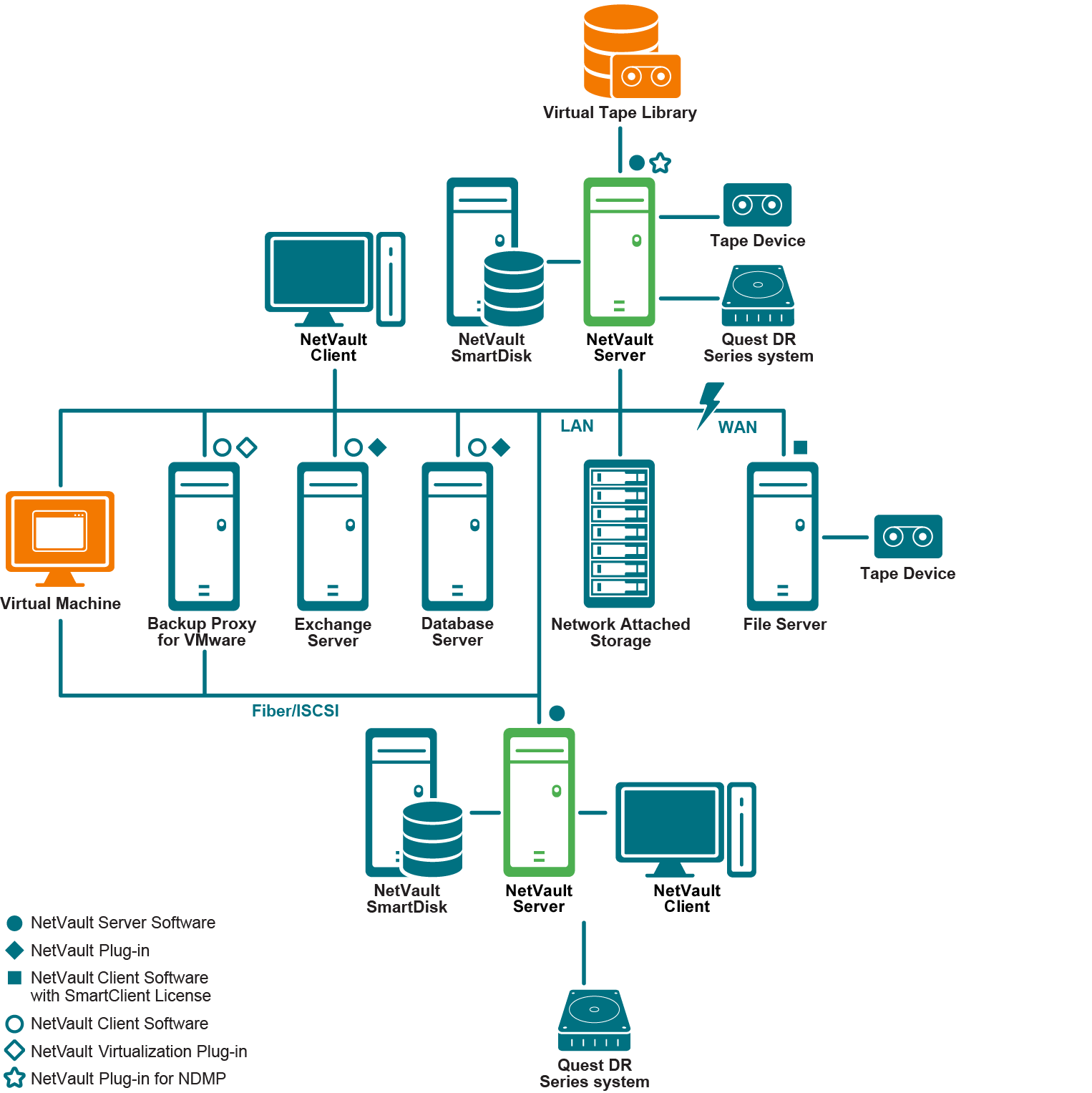Recommended additional reading
|
• |
Quest NetVault Installation Guide: This guide provides information about installing the NetVault Server and Client software. |
|
• |
Quest NetVault CLI Reference Guide: This guide provides information about using the NetVault command-line utilities. |
|
• |
Quest NetVault Plug-in for FileSystem User’s Guide: This guide provides information about installing, configuring, and using NetVault Plug-in for FileSystem. |
|
• |
Quest NetVault Built-in Plug-ins User’s Guide: This guide provides information about configuring and using the following plug-ins: |
|
• |
NetVault Plug-in for Consolidation |
|
• |
NetVault Plug-in for Data Copy |
|
• |
NetVault Plug-in for Databases |
|
• |
NetVault Plug-in for Raw Devices |
|
• |
NetVault Plug-in for Encryption |
|
• |
Quest NetVault SmartDisk Installation/Upgrade Guide: This guide provides information about installing the NetVault SmartDisk software. |
|
• |
Quest NetVault SmartDisk Administrator’s Guide: This guide provides information about administering a NetVault SmartDisk instance. |
|
• |
Quest NetVault Compatibility Guide: This guide provides information about the platforms, operating system versions, and application versions that are supported by NetVault. |
You can download these guides from https://support.quest.com/technical-documents.
Getting started
About deploying NetVault
The following diagram depicts a NetVault deployment.
About NetVault components
A NetVault deployment consists of the following components:
The NetVault Server provides the core services for protecting your data.
The server provides services such as schedule management, job management, device management, media management, user management, notification management, and log management. The server administers backup and restore jobs for all assigned clients. Various types of physical and virtual storage devices can be locally attached to the server. The NetVault Server can run on Windows and Linux operating systems.
The NetVault Clients are assigned to a NetVault Server, which manages all data protection operations for the clients. A single server and its associated clients form a NetVault Domain. A NetVault SmartClient license is required to attach physical or virtual storage devices locally to a NetVault Client.
NetVault offers the following types of built-in plug-ins:
|
• |
NetVault Plug-in for FileSystem (Plug-in for FileSystem): The Plug-in for FileSystem protects critical file system data, and minimizes downtime by allowing you to restore full volumes, individual partitions, or individual directories and files quickly and reliably with minimal interaction. |
|
• |
NetVault Plug-in for Consolidation (Plug-in for Consolidation): The Plug-in for Consolidation lets you create a composite saveset by combining a Full Backup and its associated Incremental Backups. You can use this consolidated saveset as the base for subsequent Incremental Backups. The Plug-in for Consolidation does not back up data from a client; it just creates a composite set from existing savesets. |
|
• |
NetVault Plug-in for Data Copy (Plug-in for Data Copy): The Plug-in for Data Copy lets you create one or more copies of backups for off-site storage and disaster recovery purposes. The Plug-in for Data Copy does not back up data from a client; it just creates a copy of an existing backup. |
|
• |
NetVault Plug-in for Databases (Plug-in for Databases): The Plug-in for Databases protects system data (such as configuration files, system settings, backup indexes, backup media information, job schedule, licenses, and other data) stored in the NetVault Database. You can use this backup to recover a functional NetVault Server after a failure. |
|
• |
NetVault Plug-in for Encryption (Plug-in for Encryption): These plug-ins provide support for CAST-128, CAST-256, non FIPS compliant AES-256, and FIPS compliant AES-256 algorithms to meet regulatory backup security requirements. |
|
• |
NetVault Plug-in for Raw Devices (Plug-in for Raw Devices): The Plug-in for Raw Devices protects data stored on physical disks. The plug-in lets you recover the Master Boot Record (MBR), system partitions, and individual user partitions from a point-and-click user interface without writing any complex scripts. |
|
• |
NetVault Plug-in for Rapid Data Access (Plug-in for RDA): The Plug-in for RDA lets you use the client-side and inline deduplication capabilities that are available in other products, such as Quest DR Series system of deduplication appliances and software-defined Quest QoreStor storage devices (Linux only). |
For more information about built-in plug-ins, see the Quest Plug-in for FileSystem User’s Guide and Quest NetVault Built-in Plug-ins User’s Guide.
The licensed plug-ins are available as separate products, and installed on the NetVault Server and Client machines to protect specific applications and appliances.
NetVault offers the following types of licensed plug-ins:
|
• |
Plug-ins for applications: These plug-ins provide data protection to business-critical applications, such as Oracle, SQL Server, Exchange, SharePoint, MySQL, PostgreSQL, Domino, DB2, Informix, SAP, and Sybase. |
|
• |
Plug-ins for NDMP-based NAS appliances: These plug-ins enable NDMP-based backups and restores for appliances that support this protocol. NetVault also offers specialized plug-ins that integrate the NetApp SnapMirror, SnapVault, and Snapshot technologies to provide advanced data protection to NetApp appliances. |
|
• |
Plug-ins for virtual environments: These plug-ins provide data protection to virtual machines in VMware and Hyper-V environments. |
|
• |
Plug-ins for device integration: These plug-ins enable configuration of specialized tape libraries for use in a NetVault environment. |
|
• |
Plug-ins for bare metal recovery: These plug-ins let you recover an entire system, including the operating system, applications, system settings, partition information, and data on supported Windows and Linux operating systems. |
For more information about the licensed plug-ins, see the respective plug-in user’s guide.
You can use the NetVault CLI utilities to perform various tasks such as the following:
The NetVault command-line utilities can be accessed from the NetVault Server and Client machines. For more information about the command-line interface, see the Quest NetVault Command Line Interface Reference Guide.

